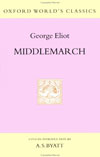What Was on Tolstoy's Bookshelf?

PAGE 10
Middlemarch and other novels
By George Eliot (pen name of writer Mary Anne Evans)
In enumerating the works that influenced him greatly during his middle years—when he wrote his great novels—Tolstoy mentions the novels of George Eliot without singling out a particular one. Parallels between Anna Karenina and Middlemarch, which appeared a few years earlier and was in Tolstoy's library, are especially revealing. Dorothea Brooke, one of the heroines of Middlemarch, finds herself in a stifling marriage and ends up falling in love with a more passionate, more articulate, more dashing younger man. The novelistic solution that George Eliot creates, however, is quite different from the tragic outcome of Anna Karenina. The contrast highlights both Tolstoy's pessimism and his take on women in relationships.
Middlemarch and Anna Karenina interweave the fates of many different characters. Instead of having all her characters related by blood or marriage, George Eliot has them all live in the same place —Middlemarch. They are neighbors. This novel explores the possibilities of neighborly love. In Anna Karenina, Tolstoy is more concerned with family love, but he is also questioning this institution, by constantly pointing to the conflict between love of family and love of others. "If one has a family, can there be love left over for others?" is one question that Anna Karenina poses.
Both George Eliot and Leo Tolstoy have breadth of vision, in addition to a penetrating eye that allows them to reveal the meaning hidden in tiny events that usually go unnoticed and sans narration. And, they both create situations that force characters to choose between selfish and selfless behavior or "living for the belly" and "living for the soul," as a peasant puts it to Levin. (p. 794)
By George Eliot (pen name of writer Mary Anne Evans)
In enumerating the works that influenced him greatly during his middle years—when he wrote his great novels—Tolstoy mentions the novels of George Eliot without singling out a particular one. Parallels between Anna Karenina and Middlemarch, which appeared a few years earlier and was in Tolstoy's library, are especially revealing. Dorothea Brooke, one of the heroines of Middlemarch, finds herself in a stifling marriage and ends up falling in love with a more passionate, more articulate, more dashing younger man. The novelistic solution that George Eliot creates, however, is quite different from the tragic outcome of Anna Karenina. The contrast highlights both Tolstoy's pessimism and his take on women in relationships.
Middlemarch and Anna Karenina interweave the fates of many different characters. Instead of having all her characters related by blood or marriage, George Eliot has them all live in the same place —Middlemarch. They are neighbors. This novel explores the possibilities of neighborly love. In Anna Karenina, Tolstoy is more concerned with family love, but he is also questioning this institution, by constantly pointing to the conflict between love of family and love of others. "If one has a family, can there be love left over for others?" is one question that Anna Karenina poses.
Both George Eliot and Leo Tolstoy have breadth of vision, in addition to a penetrating eye that allows them to reveal the meaning hidden in tiny events that usually go unnoticed and sans narration. And, they both create situations that force characters to choose between selfish and selfless behavior or "living for the belly" and "living for the soul," as a peasant puts it to Levin. (p. 794)



